So many humans live on Earth, it’s hard to imagine there are animals we haven’t seen for years, decades or even millions of years, but it keeps happening! Animals believed extinct that were found alive even have a name. They are called “Lazarus Animals” after the biblical Lazarus who rose from the dead.
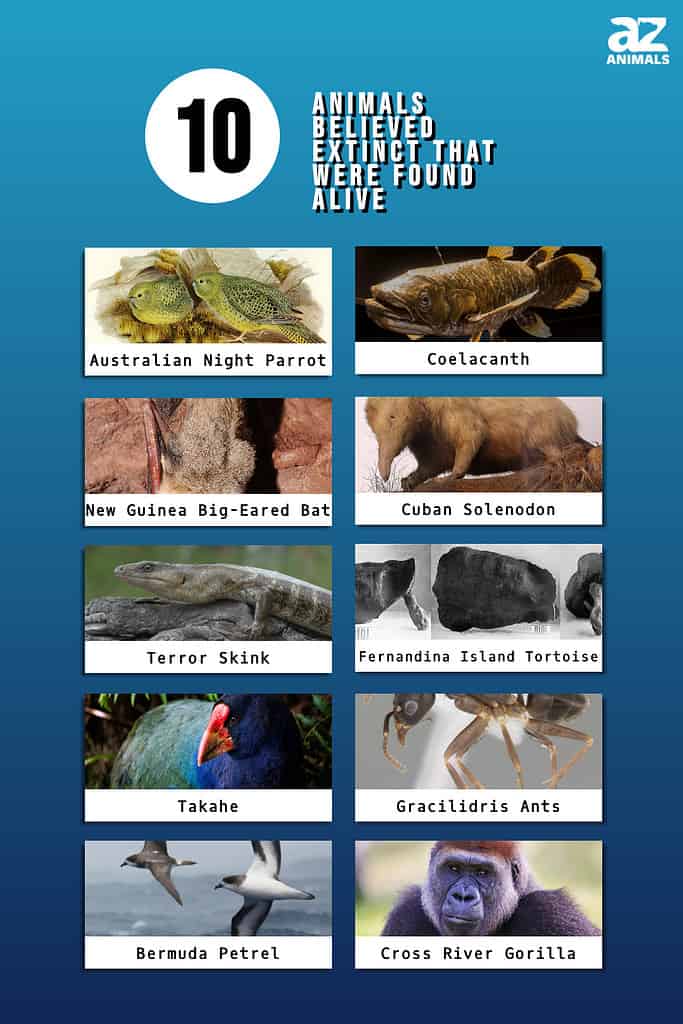
Here are 10 Lazarus animals that are alive extinct animals that we thought were gone forever but made a comeback.
1. Australian Night Parrot (Pezoporus occidentalis)
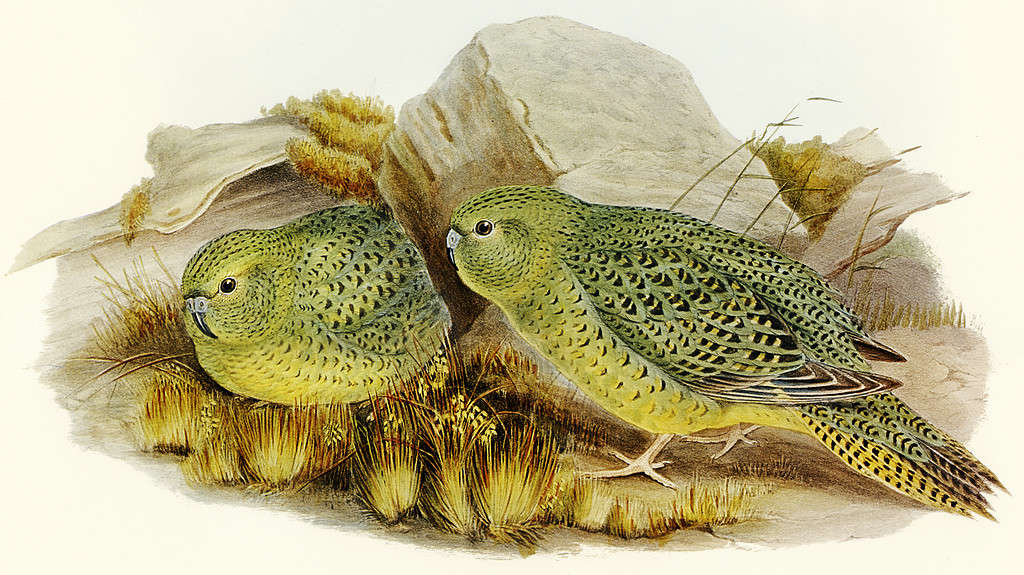
Australian night parrots disappeared from records in 1912 but rediscovered 100 years later in 2013.
©Rawpixel / CC BY-SA 4.0 – License
Australian night parrots are alive extinct animals. They are in fact, not extinct animals and are small and short-tailed with yellowish-green, dark brown, black, and yellow foliage. From their name you’ll be able to guess they’re nocturnal! These cute little birds disappeared from the records in 1912.
Scientists thought the cats and foxes introduced by settlers decimated the population, but in 1990 a dead one was found on the roadside in Queensland.
A naturalist called John Young dedicated 15 years to the search and was rewarded in 2013 when he photographed a live Australian night parrot one century after the last one was recorded.
However, some of Mr Young’s evidence was questioned and in March 2019 the Australian Wildlife Conservancy removed some of the new records.
Australian night parrots are classed as an endangered species and their population number is unknown.
Still elusive but not extinct yet!
2. Coelacanth (Latimeria chalumnae)
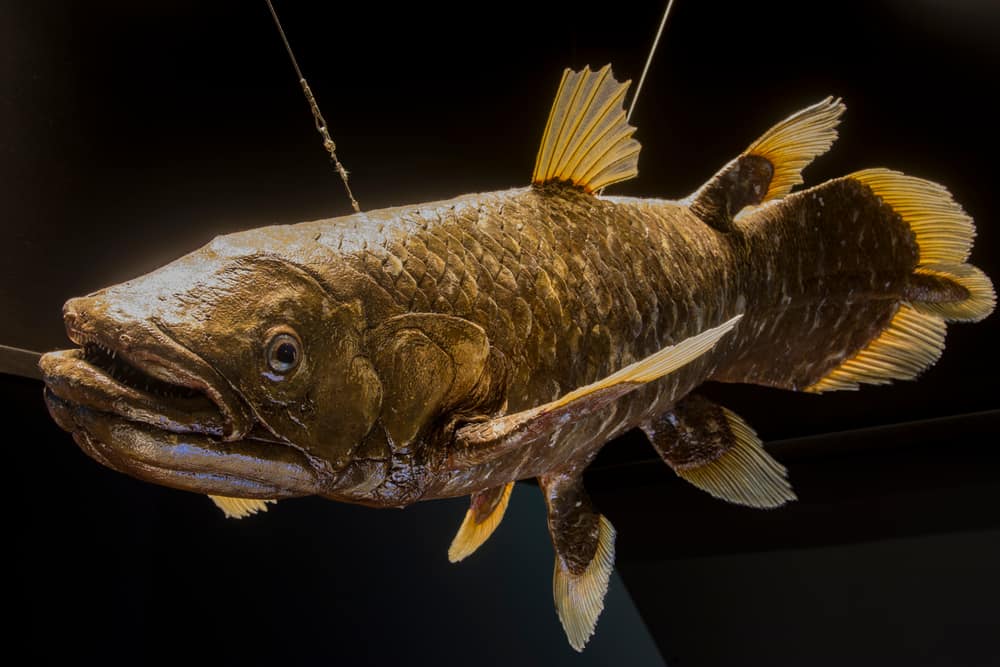
The Indonesian Coelacanth (
Latimeria menadoensis) is a living species of coelacanth, identifiable by its brown color.
©Danny Ye/Shutterstock.com
It isn’t a record of animals believed extinct but found alive without the infamous coelacanth!
Scientists thought coelacanth (pronounced “see-la-canth”) became extinct with the dinosaurs 65 million years ago, but in 1938 one was caught in the West Indian Ocean near South Africa. Another coelacanth was caught in 1998 on the coast of Indonesia.
Not one but two living species of animal thought to have died out millions of years ago. What a comeback!
The two coelacanths each weighed close to 200 pounds and measured over six feet long, so it’s surprising humans hadn’t discovered them before. Their discovery caused a big stir in the scientific community not least because it’s a type of fish that tetrapods evolved from.
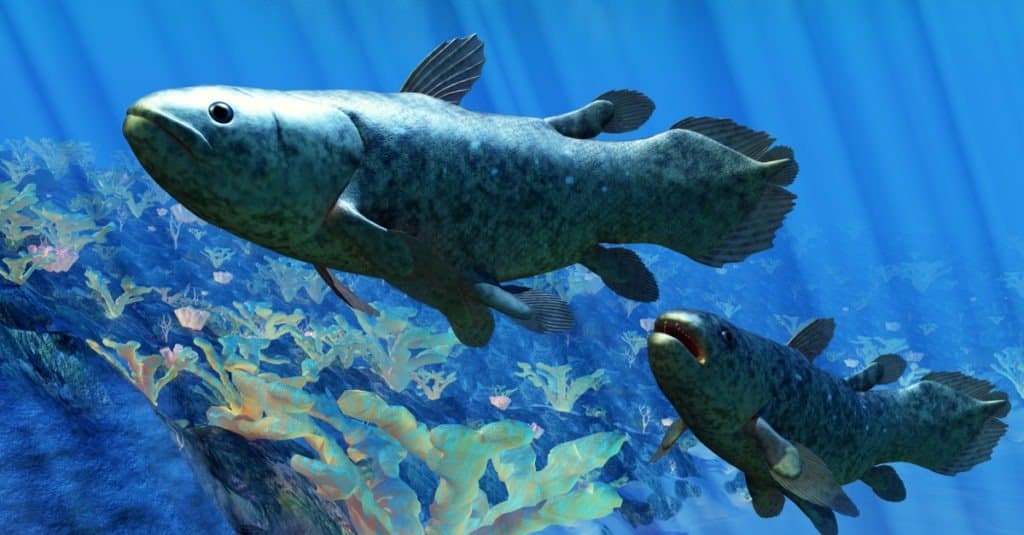
Coelacanth were thought to be extinct for millions of years.
©Catmando/Shutterstock.com
3. New Guinea Big-Eared Bat (Pharotis imogene)

The New Guinea big-eared bat (not pictured) is a type of vesper bat (pictured above) endemic to Papua, New Guinea.
©Thomas Bresson / CC BY 2.0 – License
The New Guinea big-eared bat doesn’t look much different from other bat species which is why it may have hidden from sight for so long.
The main differences are its ear size, nostril skin, and curved nose. You’d have to be a bat expert to tell the difference!
It was first observed just once in 1890 and was presumed extinct until 2012 when researchers studying the effects of logging on microbats accidentally caught one!
Due to its rarity, the female bat wasn’t identified as a New Guinea big-eared bat until a bat expert realized what it was two years later.
Logging is destroying habitat at a fast rate in Papua New Guinea and scientists are left wondering if this elusive bat will ever be spotted again. As a result, it’s on the critically endangered list.
4. Cuban Solenodon (Solenodon cubanus)

The Cuban solenodon is one of the world’s few venomous mammals.
©Emőke Dénes / CC BY-SA 4.0, Wikimedia Commons – License
This little nocturnal shrew-like rodent is native to Cuba and lives in the Nipe-Sagua-Baracoa mountain range where it hunts insects. It’s one of the very few venomous mammals in existence!
They were declared extinct in 1970, but researchers found them again in 1974. Since the early 1980s solenodons have been on the endangered species list.
There are two species of solenodon today. The once-thought extinct Cuban species and the Hispaniolan solenodon. Solenodon are descendants of a group of insectivores that lived at the same time as the dinosaurs 76 million years ago so they’ve been around a very time!
However, their habitat is now under threat and introduced invasive species such as the small Asian mongoose prey on them so their population is waning. It’s sad to think this animal believed extinct but found alive might soon be extinct for good.
5. Terror Skink (Phoboscincus bocourti)

The terror skink received its name for being an avid carnivore with sharp curved teeth.
©DECOURT Théo / CC BY-SA 4.0 – License
The fantastically named terror skink is a 20-inch long lizard native to New Calendonia in the Pacific Ocean. It’s called the terror skink because it’s an avid carnivore with sharp curved teeth.
Fossil specimens were unearthed in 1867 and it was considered extinct until a live terror skink was found in 1993. Another was discovered by a French museum specialist in 2003 then only a few more in 2009 and 2013. The last one was seen in 2018.
Terror skinks live on two islands whose combined surface makes only 0.35 square miles! Its territory is a small area without a great deal of human occupation so it’s not a big surprise that they aren’t spotted often.
Who knows, they may be on other islands too, but they’re so quick and shy we just haven’t seen them there.
6. Fernandina Island Tortoise (Chelonoidis phantasticus)

A rare image of a Fernandina Island tortoise. There is a known living one in captivity and two more believed to be living on Fernandina Island.
©John Van Denburgh (1914) / Public Domain – License
Though it was thought extinct for 100 years, the Fernandina Island tortoise made a comeback in 2019.
This beautiful tortoise has extremely flared scutes (that’s the pieces making up its shell) and Galapogos-specific saddle-backing on the front carapace.
The lone female was found on the Northwestern flank of the Fernandina Island’s volcano and is 50 years old. She now lives in Galapagos National Park Tortoise Center.
Tracks and scat suggest there are at least another two Fernandina tortoises close by. This might put to bed the idea that the original Fernandina tortoise found in 1906 was taken there by travelers.
There’s an article in Communications Biology journal about her genome sequence and how it indicates she’s related to the 1906 tortoise despite her stunted growth and slightly odd appearance.
7. Takahe (Porphyrio hochstetteri)
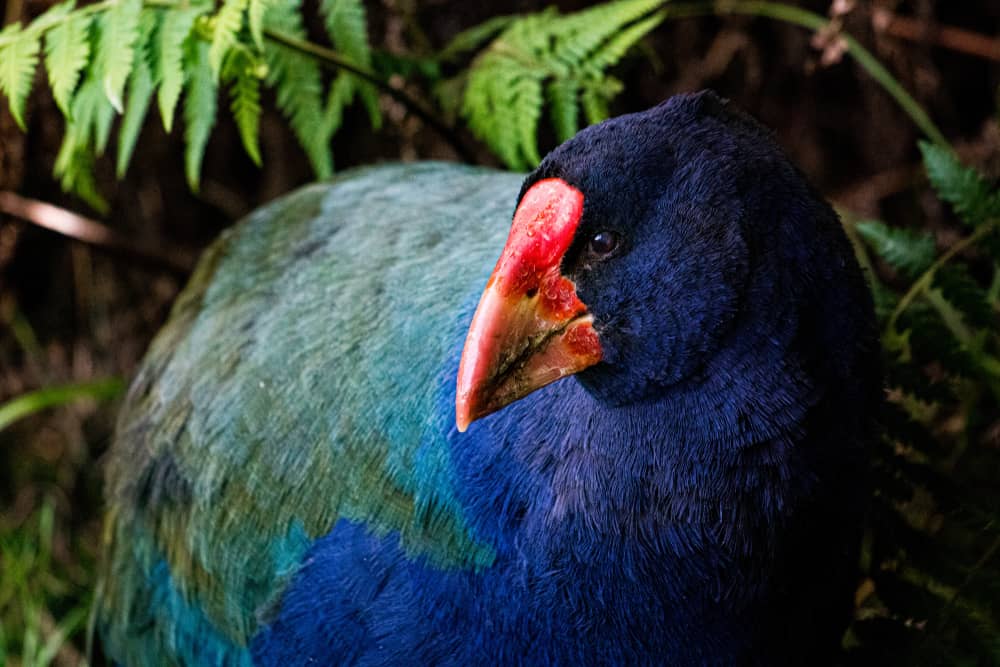
New Zealand takahes were thought to be extinct until 1948.
©Richie White/Shutterstock.com
Indigenous to New Zealand, this flightless swamphen was hunted by Maori for centuries before Europeans classified it. It’s a beautiful bird with iridescent dark blue feathers on its head and bright blue wings. Its back is teal green, its tail is white, and its beak is red! How this beauty remained hidden for 50 years is a mystery.
Takahes were discovered and classified by fossilized bones in 1847, then live takahes were captured in 1850 and 1898. After that, they disappeared due to colonists introducing predators such as cats and dogs. They were presumed extinct until 1948 when explorers led by Geoffrey Orbell found one in the Murchison Mountains.
They now live in New Zealand refuges and there are about 300 individuals. In 2018, 30 takahes were released back into the wild in an effort to re-start the population.
8. Gracilidris Ants (Gracilidris pombero)
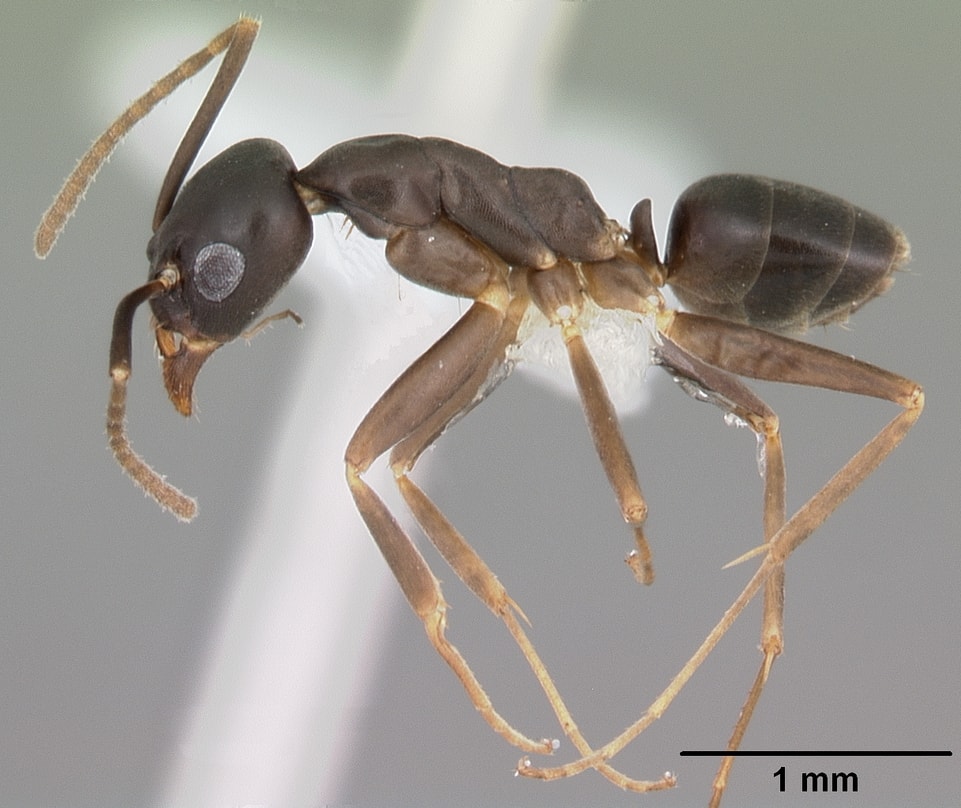
The ant species Gracilidis was considered extinct 15 million years ago.
©www.antweb.org / CC BY 4.0 – License
It seems that being very small, burrowing deep, and only leaving the nest at night is enough to make humans think you’re extinct!
This is what happened with the ant species Gracilidis. It was only known by a single amber-fused fossil and the species was considered extinct for over 15 million years. However, in 2006 it appeared throughout South America.
There are more than 10,000 different species of ant, and because Gracilidris pombero is new to specialists we know little about them. It’s thought they were discovered in the Colombia Amazon Basin foothills due to logging and other human disturbances in the environment.
9. Bermuda Petrel (Pterodroma cahow)

Bermuda petrels are still alive and well, though they were called extinct in 1620.
©Richard Crossley / CC BY-SA 3.0 – License
The Bermuda Petrel was considered extinct since 1620, but more than 300 years later 10 nesting pairs were found! They were discovered in the remote Castle Harbor islets on the south-eastern corner of Bermuda.
Bermuda Petrels were so loud and frightening that European explorers called Bermuda an island of demons. That was before they discovered the petrel’s ground-based nests! Explorers ate the eggs and brought their domesticated cats and dogs with them. It had such an impact that the Bermuda Petrel population disappeared.
It’s thought about 250 exist now, which is not a lot, but it’s better than extinct. The population is on the rise thanks to a breeding program.
10. Cross River Gorilla (Gorilla gorilla diehli)
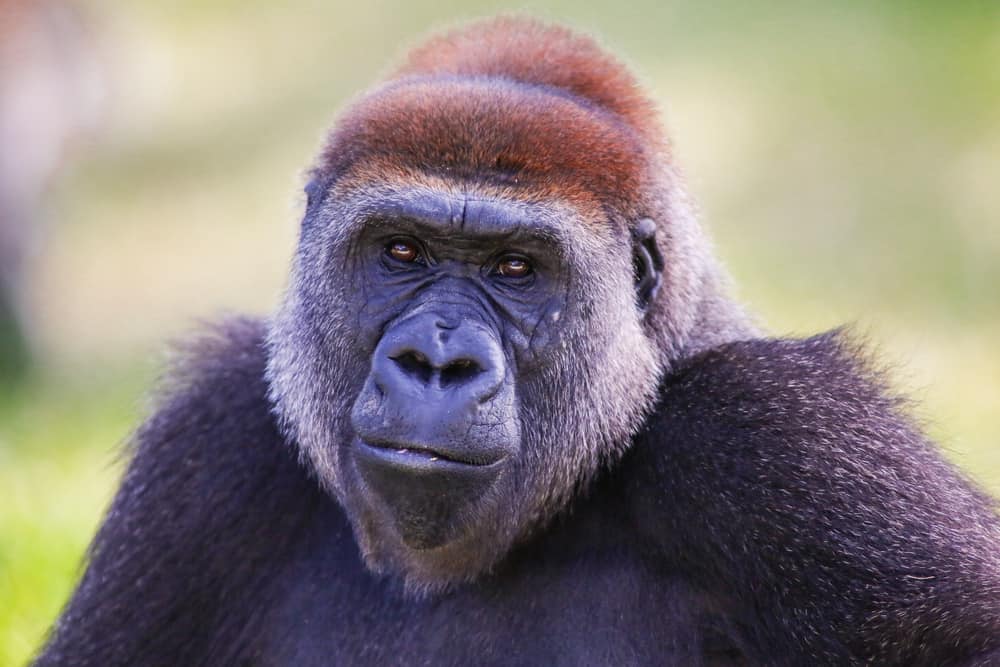
There are only around 200-300 cross river gorillas remaining.
©Kit Korzun/Shutterstock.com
Cross River gorillas are a subspecies of gorilla on the critically endangered list. They live in Cameroon and Nigeria’s forests but there are only 200-300 left.
Cross River gorillas were found in 1904 but left unstudied and thought extinct until 1987 when a small population was rediscovered. It wasn’t until 2009 that conservationists managed to get photographic evidence of family groups with babies.
This is good news because it means they are reproducing in the wild. Hopefully, their dwindling numbers will increase now that African governments have created sanctuaries for them in their native area.
So, there you have 10 animals believed extinct that were found alive. The majority are still elusive and most are endangered.
Their stories are incredible and many were pushed to the brink of extinction because humans overhunted them or destroyed their environments. Their stories are evidence that humans activity has a big impact on wildlife.
Bonus: How Does the ICUN Declare an Animal to be Extinct?

The International Union for Conservation of Nature (ICUN) determines whether an animal is extinct.
Image: metamorworks, Shutterstock
©metamorworks/Shutterstock.com
The International Union for Conservation of Nature (ICUN), the oldest and largest global environmental union, consists of over 9,000 scientists, researchers, and animal experts in 162 countries who compile the Red List of endangered species. They also determine when a species is declared extinct and until recently that declaration was made if the animal hasn’t been spotted for 50 years.
Those guidelines were refined in the 1990s – a species can now only be listed as extinct if there is no reasonable doubt that the last individual member has died. Experts factor in data on population size, number of breeding adults, geographic range, and habitat degradation for every species under review. A determination of extinction requires exhaustive surveys in the appropriate habitats – including nighttime surveys for nocturnal animals.
By some estimates, populations of mammals, amphibians, birds, reptiles, and fish have declined by almost 70% since 1970. By the time a species is endangered most of the damage is done. The ICUN has begun focusing on the Green Status of Species in contrast to the Red List – to measure the extent to which a species has recovered and how much conservation efforts have helped. Species on the Green List will get a score from zero (extinct in the wild) to 100 (fully recovered). The full recovery means that the species is playing its natural role in the ecosystem.
Summary of 10 Animals Believed Extinct That Were Found Alive
Here’s a recap of the animals that were thought to have disappeared from the planet but are fortunately still around!
| Number | Animal | Scientific Name |
|---|---|---|
| 1 | Australian Night Parrot | Pezoporus occidentalis |
| 2 | Coelacanth | Latimeria chalumnae |
| 3 | New Guinea Big-Eared Bat | Pharotis imogene |
| 4 | Cuban Solenodon | Solenodon cubanus |
| 5 | Terror Skink | Phoboscincus bocourti |
| 6 | Fernandina Island Tortoise | Chelonoidis phantasticus |
| 7 | Takahe | Porphyrio hochstetteri |
| 8 | Gracilidris Ants | Gracilidris pombero |
| 9 | Bermuda Petrel | Pterodroma cahow |
| 10 | Cross River Gorilla | Gorilla gorilla diehli |
The photo featured at the top of this post is © iStock.com/Jef Wodniack
Thank you for reading! Have some feedback for us? Contact the AZ Animals editorial team.






